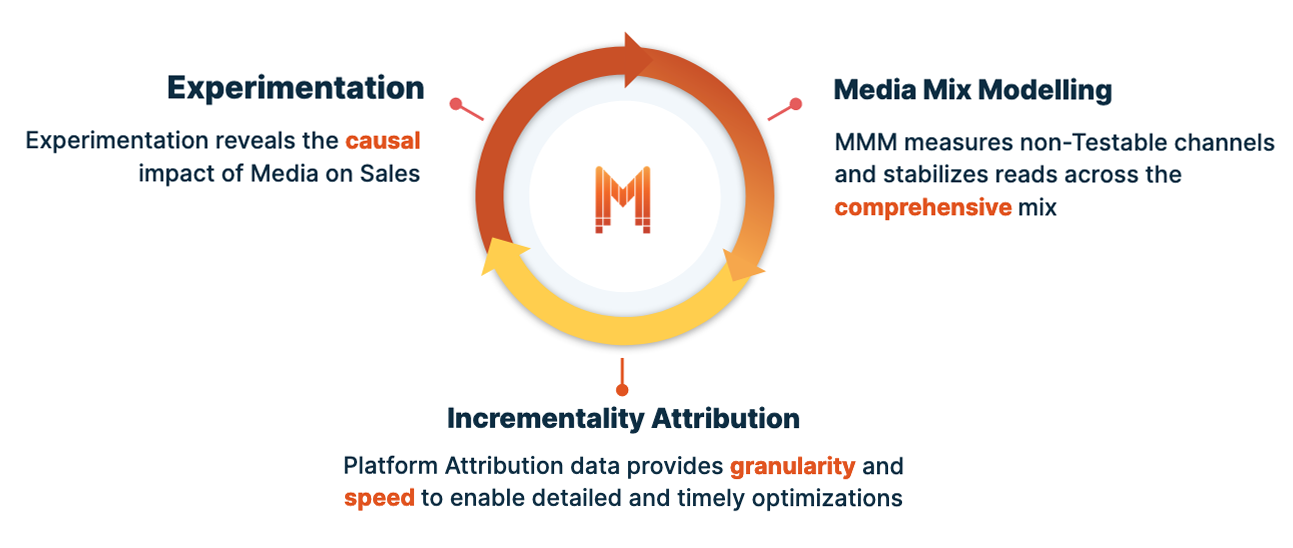MIM: Concepts and Overview
Getting Started
The Measured Incrementality Model (MIM) is the engine behind the insights that Measured provides into your marketing performance. The foundation is your media mix model, which triangulates multiple sources:
- Your marketing performance data
- Your business's transactional data
- Results from your incrementality tests
By combining these factors, you get a comprehensive view of how effective your media spending is across your entire portfolio.
They inform your MIM so it can define the adjustment factor we use to correct metrics reported by your integrated platforms. This adjustment factor is used for forecasting and optimization throughout Measured.
Go to our product video hub for brief overviews on the Measured features that MIM powers.
What's New in MIM
MIM uses diminishing return curves provided by your media mix model to evaluate the incremental performance of your entire media portfolio. All of your marketing channels, both online and offline, are covered by this comprehensive measurement method.
The results from tests you run on your tactics can be automatically used to calibrate your specific model. The most recent update to the model makes it possible to integrate results from any holdout tests that have been completed, including flat or negative results.
Additionally, select tactics can have ad stock effects incorporated to provide more realistic reporting on your channels. This means that the gradual decrease in impact from your campaigns that have ended will be taken into account, instead of them having an immediate drop-off.
We will continue to expand the range of tests that can be drawn upon for calibration and tactics that ad stock effects can be applied to with future updates.
Spend Input
Your MIM results use the performance data from your integrated platforms as a primary input, but there are cases where a different source is necessary, like with Amazon and retail channels. This is why MIM has been updated to allow for spending data as an input to your model.
The same diminishing return curves that provide results from your platform orders will still be used when spend is metric used for modeling, but adjustment factors will not be necessary since your results will be based on transactional data and there are no reported conversions or orders to adjust.
Enabling MIM
Reach out to your customer success partner to review the latest model results, then let them know when you’re ready to enable it. In addition to the benefits that were previously mentioned, MIM will be a key part of upcoming Measured updates.
For instance, we will soon be showing visualizations of the diminishing returns stemming from what you are spending on your marketing. MIM will be necessary for these calculations.
What is MIM?

MIM provides full-funnel, causal measurements of your media spending. This information becomes the suite of Measured applications, from the metrics on your Homepage to the recommended budget plans in Media Plan Optimizer.
- Each day, your media mix model will update for each of your conversion events. It will draw upon up to three years of your marketing data, plus your business data and experiments. It will comprehensively measure all of your channels and tactics. The more tests you run, the more calibrated and accurate your media mix model becomes.
- For models based around platform orders, MIM will then calculate the ratio of incremental orders from your media mix model to platform-reported orders, weighted by recency for each of your tactics. This ratio is used as the adjustment factor, which powers your reporting, optimizations, and forecasting throughout Measured.
You can view your tactics’ recent incremental performance with the most up-to-date adjustment factors on your MIM page. You can then request that they are applied to your reporting through your customer success partner whenever you see fit.
This multi-step approach spans both testable channels like social, search, and email, as well as non-testable channels like affiliate, radio, and podcasts. As a result, your entire portfolio can be measured granularly on the channel, tactic, and campaign levels.
Calibration Requirements
In order for MIM to calibrate a tactic, basic criteria must be met. If you find that your model is showing no results for a specific tactic, confirm the following:
- It must show orders to the platform it stems from within whichever of the following timeframes is shortest:
- Within the past 3 years
- Since that first order from that platform was reported
- It must have more than 2 weeks of spending data
- It must be be properly mapped via the Campaign Mapper
- It cannot have any pending changes to its mapping
How Is MIM Calibrated?
With the latest version of the Measured Incrementality Model, many of your geo tests will now automatically calibrate your media mix model. The effect of each test on the model depends on the probability that your tactics are driving a positive impact, how recent the test was, and the strength of other competing signals in the model (such as your tests on other tactics).
This version of the model will use results from any holdout tests for calibration. Future iterations will expand the range of tests that can be drawn upon to inform your model. The result of model calibration will be an updated adjustment factor for reporting and updated diminishing return curves.
This calibration process also applies to the results of multi-tactic tests. These tests have an adjusted method to determine the most accurate results for all tactics involved. Learn more about multi-tactic testing here.
After a geo test finishes and your model is calibrated, you can apply the latest adjustment factor(s) to your reporting when you next make an on-demand update request.
MIM In Action
Here's a common example of how the above factors are used to calibrate an incrementality model for a specific company:
- A brand uses their media mix model-powered MIM to make informed investment decisions, including where to run a geo test and what type of test it should be.
- Based on their data and business objectives, they plan and launch a channel geo test for Facebook, and the results show the incremental performance, or how effective the channel truly is.
- While useful, channel-level results aren't helpful with tactical optimizations, so the brand uses their MIM to get tactic-level insights out of the Facebook channel test.
- The brand then applies those learnings to their platform reporting through updated adjustment factors. These updates power the incremental metrics they see in Measured, and help the brand make optimization decisions with confidence.
Updates to Your MIM
Your MIM and the media mix model that power it will update each day based on the last 3 years of your reported business activity.
You can configure how these updates affect your Measured experience. MIM gives you control over when and where your latest model results are applied for each tactic through on-demand updates, which let you determine your own update cadence.
You can use your MIM page to review your most recent model results and manually request updates to your adjustment factor. You can also specify how your latest adjustment factor will be applied retroactively.
Why Adjustment Factors Change
The adjustment factor represents the accuracy of the reporting from your integrated platforms. It is defined as the ratio of incremental orders from your media mix model to the amount of orders originally reported by your marketing channels.
Each day, your media mix model runs using the last three years of data (if available). This process will add any new test results and new marketing channels.
As your MIM updates each day, you can expect significant changes in its results based on new tactics being added, new geo test results, or when there is a significant change in the business activity that your platforms have reported.
Note: If you see an incrementality percentage of 0%, this means the vendor reported no conversions during your chosen timeframe.
FAQs
Will the Measured Incrementality Model be responsive to changes to my marketing?
MIM leverages media mix modeling to find the incremental contribution to your sales, and then uses reporting from your ad platforms to highlight ideal short-term optimizations. This makes MIM responsive to changes in your performance, while ensuring your decisions have a solid foundation in incrementality.
What conversion events are included in the media mix model?
All conversions are included in your media mix model except for “roll-up” events. (For instance, “All Orders” is a roll-up of Online Orders and Retail Orders.) Those aggregated conversion types combine the spend and incremental orders from the individual conversions in Measured's reporting.
How is the incrementality for sub-campaigns found?
Adjustment factors are defined at a tactic level. When they are updated, they are passed through to the campaigns and sub-campaigns that they contain.
Is MIM a weighted average of multiple inputs? Can I see those separate inputs?
No, it is not a weighted average. The only inputs are your tests, your media mix model and the reporting from your ad platforms. MIM uses your media mix model, calibrated by your tests, to measure the incremental contribution of your tactics to sales.
Are you incorporating diminishing returns, seasonality and pricing in my media mix model?
A: Yes. Seasonality and diminishing returns are included in your media mix model, and pricing is factored in for Shopify clients. A baseline conversion value is derived from the model to account for seasonality and pricing, while diminishing returns are imposed on your model.
When should I apply the latest model results?
We recommend updating the adjustment factors for your tactics at least once a month. It is also best practice to update them after receiving new geo test results, adding new channels or tactics, or when a new version of MIM is released.
How does MIM deal with the "cold start" problem - tactics with limited or no spend history?
MIM has a special feature for new tactics with less than 2 weeks of available data. It uses media mix models and testing insights from other brands to estimate the tactic’s initial incrementality. Once we have more than 2 weeks of data on a tactic, this method has less impact on your results.
How are test results used to calibrate the media mix model?
Your test results factor into your media mix model as a definitive signal of your tactics' performance. Since we directly observed your results happening due to real world conditions, we can say that these are the most accurate tactic measurements to factor in.
How are you measuring the accuracy of the media mix model?
The media mix model uses standard statistical accuracy metrics such as VIF, R^2, and MAPE.
